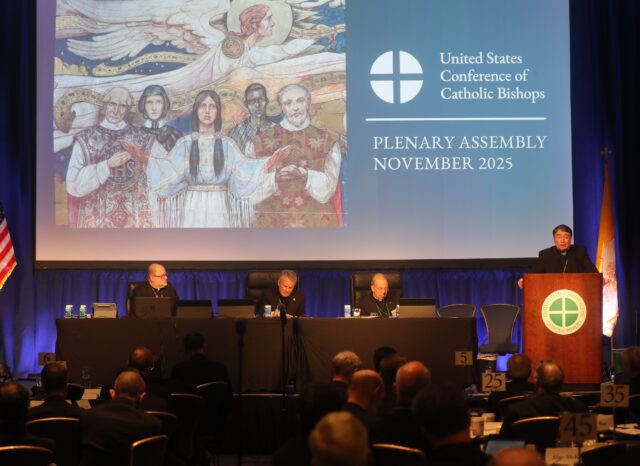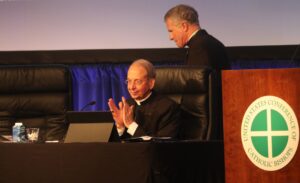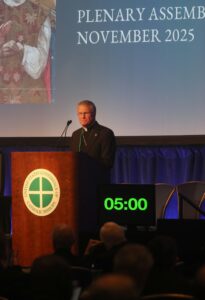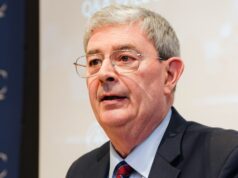
BALTIMORE — In his farewell address to his brother bishops, Archbishop Timothy P. Broglio of the U.S. Archdiocese for the Military Services, outgoing president of the U.S. Conference of Catholic Bishops, emphasized the need to “convince people to listen to each other” amid polarization.
“We have to draw on our unity to illustrate that civil discourse is not only possible, but the most authentically human way forward,” he told the bishops gathered Nov. 11 for their annual fall plenary assembly in Baltimore.
Archbishop Broglio said he had mentioned to Pope Leo in October that “some of our faithful listen more readily to sound bytes, the sirens of political discourse, or whatever confirms their conclusions and partisan leanings” instead of “hearing their pastors and us.”
“The ease of sending an e-mail has diminished common courtesy and, if I may be so bold, even common sense,” he continued. “Our task, as unworthy successors of the apostles, is to proclaim the truth in and out of season, reaffirm the dignity of the human person and find ways to make the Gospel resound at the very least in the hearts of believers, if not from shore to shore.”
During his time working in Rome at the Secretariat of State in the Apostolic Palace years ago, he said, he enjoyed visiting “an empty Sistine Chapel before the Vatican Museums were open,” saying “the vivid images of Michelangelo’s Last Judgment always captured my attention.”
Those images have remained with him, he said, as he “issued a few reminders to interlocutors to remember that Jesus already told us the ‘exam’ questions for the final judgment. There is no room for doubt and the preparation is daily.”
“Jesus identifies with the hungry, thirsty, helpless, unborn, stranger, naked, homeless and prisoner. He assures us that we meet Him in those others,” he emphasized. “It should surprise no one when we defend the unborn, meet the basic needs of the immigrant, lobby for immigration reform, reach out to those in need outside our borders through CRS and call upon others to do the same.”
Archbishop Broglio recalled “a weak, ill-advised moment” when he “responded to an irate email and suggested that my interlocutor read Matthew 25. The response came quickly: I should read the catechism.”
“How can it be that someone would actually believe that the catechism and the Gospel do not agree and give the same message,” he wondered. “Our work, brothers, is cut out for us and much remains to be done.”
“We must also convince people to listen to each other,” he emphasized. “May the lessons learned through the synod spread throughout society so that we might take the time to listen to the other, and if we must disagree, we do so with courtesy, appropriate speech and even attentiveness to the personal situation of the other.”

Archbishop Broglio also emphasized the generous assistance provided by the faithful to those impacted by Hurricane Melissa’s devastation in Jamaica, Haiti and Cuba.
He also noted that he “was shocked to learn that 42 million people are dependent on assistance from SNAP. In a country of such wealth and such possibilities, we should be able to do better so that all are able to share in the bounty of this land.”
He shared an appeal from the Franciscans of the Holy Land who asked for aid “in fostering assiduous growth in the participation in the annual collection for the Holy Land” as “the need there is extreme and the war in Gaza has only exacerbated the suffering for the dwindling Christian population in the land where Jesus walked.”
Archbishop Broglio concluded his address by thanking his brother bishops for their “unity, confidence and support, especially as I was stretched to speak for all of us in defense of the unborn, the stranger and the poor.”
Following Archbishop Broglio’s address, Cardinal Christophe Pierre, apostolic nuncio to the United States, gave his first address to the conference as Pope Leo XIV’s representative. He opened with the two-fold question: “Where have we been and where are we going?”
He approached the question by “placing it under a guiding light: the teaching and vision of the Second Vatican Council.” He emphasized that Vatican II “remains the key to understanding what kind of church we are called to be today, and the reference point for discerning where we are headed.”

“Pope Leo also is convinced of this,” he added. “Two days after his election, he told the cardinals: ‘I would like us to renew together today our complete commitment to the path that the universal church has now followed for decades in the wake of the Second Vatican Council.'”
“The documents of the Second Vatican Council,” he said, “gifted the church with a map for the journey ahead.”
“The council’s documents were not fully understood in their time,” he said because “they were not a description of where the church stood, but a map drawn for the territory into which she was being sent. Today, that territory is our daily experience. We now inhabit the world that the council foresaw — a world marked by profound cultural shifts, technological change and a secularized mindset that challenges faith at its roots.”
The pontificate of Pope Francis, he said, “was marked, not by innovation for its own sake, but by a call to live more fully the vision of the council. ‘Evangelii Gaudium’ and ‘Fratelli Tutti’ both reflect that vision: a missionary church, joyful and outward-looking, a community that builds fraternity in a divided world.”
Noting the “pivotal moment” of transition from Pope Francis to Leo XIV, Cardinal Pierre said, “even if some may be inclined to pursue paths that turn aside from the pastoral vision of Pope Francis, we know that the way forward is not to diverge, but to advance along the road he helped to illuminate — a road on which Pope Leo continues to lead us.”
Cardinal Pierre praised Pope Leo’s vision for Catholic education in his recent apostolic letter “Drawing New Maps of Hope” which marked the 60th anniversary of the conciliar declaration “Gravissimum Educationis.”
“This vision renews our dedication to formation in all its dimensions,” the cardinal said, “to families as first educators; to schools that are both strong and accessible; to universities that serve culture through ‘an inclusive outlook and attention to the heart’; and to policies that protect the poor — since, as the Holy Father reminds us, ‘losing the poor’ is equivalent to losing the school itself.”
Cardinal Pierre said that “the true vitality of Catholic education” depends “on how deeply it embodies the vision of Vatican II,” and “Catholic education thus offers a window into the wider story of how the council’s teaching has been received across the church in this country.”
“The council’s call to unity challenges us to resist the divisions that fracture our witness,” he emphasized. “Polarization too often allows Catholics — even within the same parish or family — to identify more with tribes and ideologies than with the body of Christ. The synodal path invites us to a different way: a style of being church that makes communion concrete, allows dialogue to become discernment and catholicity to become shared mission.”
Cardinal Pierre asked the bishops, having received so much from the council’s vision, “the question now becomes: What does that ask of us as bishops? How are we to represent the church the council described?”
In part, he said, it means avoiding “both ideological narrowing and vague generality, proclaiming the whole Gospel with clarity and love” and in “engagement with public life, we are not chaplains to parties or distant commentators, but shepherds who bring the breadth of Catholic social teaching into the civic discourse in a way that transcends partisanships.”
He also urged those assembled to “never forget the call Pope Leo XIV places at the heart of ‘Dilexi Te’: to renew our saving relationship with the poor, whose poverty takes many forms — migrants seeking dignity, victims of human trafficking and abuse, families denied a fair chance to improve their lives.”
“The council’s documents continue to form us and guide our discernment of this moment,” he concluded. “Pope Leo XIV now carries that same vision forward, interpreting it anew for the world of today. If we walk faithfully with him, we will be the church the council envisioned: A pilgrim people, a sacrament of communion, a beacon of hope, and a servant of the poor — drawing, even now, new maps of hope for the generations to come.”








